Yamaha CP70B repair
Fix the Yamaha CP70B electronics by eliminating them altogether and
make the CP70B sound better!!!
Bypassing that old 1980’s circuitry is simple and makes the Yamaha Electric Grand more reliable.
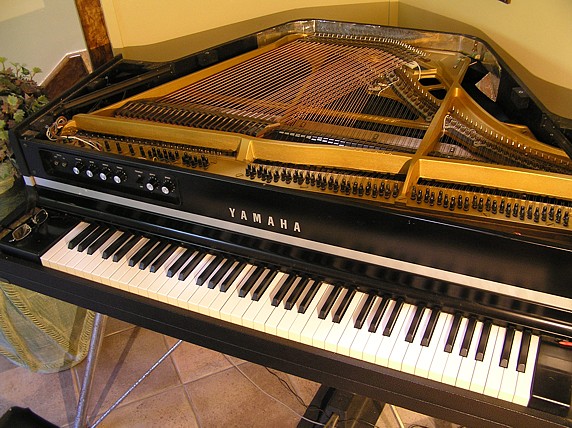
My Yamaha CP70b Electric Grand Piano has been very reliable and it stays in tune for ages. 3 years ago the electronic part of it stopped working. I found the schematics for it at http://www.synthfool.com/docs/Yamaha/Yamaha%20CP-70B%20Operating%20Manual.pdf , and a forum for it at http://www.pianochopshop.com/forum.html and I finally diagnosed the problem to a poor connection on one of the pins.
While searching the net for answers I discovered that the Yamaha can be connected to an amp, UNPOWERED, just like a guitar. This bypasses ALL of the circuitry, which is one less thing that can go wrong, but more importantly,
IT SOUNDS A LOT BETTER!!!
The bypass is so simple it can be done by twisting wires around 3 connectors, no soldering or electrical knowledge necessary. I tested the piano by playing for 10 minutes or so using the onboard pre amp that I had fixed and then using this bypass method. The difference was quite audible, less bass boom being most noticable. The stereo tremelo effect is lost but that is a small price to pay.
I preferred the bypass sound so I decided to make it permanent. I didn’t cut any wires and the process is completely reversible.
Simply connect the WHITE wire from the piezo’s that goes IN to the board, with the RED and WHITE wires that come OUT of the board. Obviously these wires must be disconnected first from the board. Leave the EARTH wires connected.
INSTRUCTIONS –
At the left end of the circuit board behind the Volume control, these RED and WHITE wires are pushed onto pins in the board. They go directly to the OUTPUT – XLR and Jack sockets.
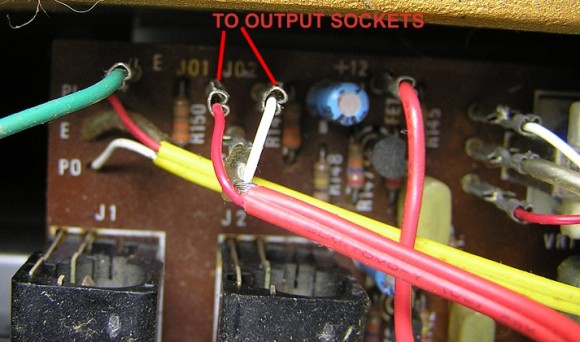
At the right end of the board the positive WHITE wire and it’s Earth come from the Piezo pickups and go into the board. You can see the pin and the wire connector I have pulled off it.
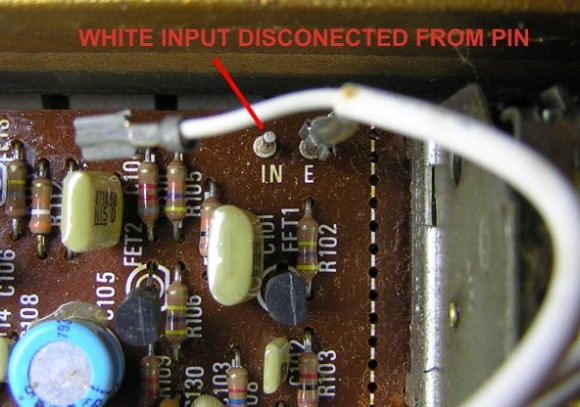
Disconnect the RED & WHITE Output wires. These are the LEFT & RIGHT output wires and need to be connected together. Solder or wrap them together and join them to a length of insulated wire.
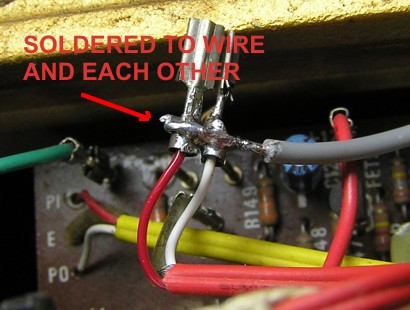
Solder or wrap the other end of the new piece of wire around the connector on the WHITE input end and then tape it up.
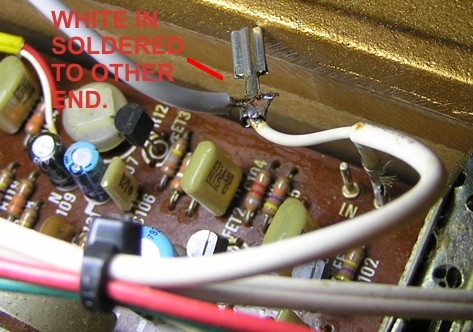
The circuit is now bypassed. I take the output from the mono jack sockets to the CD input on a Yamaha home stereo amp and I have about the same volume as a standard piano. I am enjoying the new sound, it hasn’t lost that signature CP70B timbre, but the bass is much clearer and more natural.
Here’s an overview showing the grey wire I used to bypass the old preamp. The Yamaha doesn’t need any power now and I can undo this bypass simply by unsoldering the wires and poushing them back onto their connector pins.
Kudos to whoever invented this simple fix for old electronics. I got my info from John Smithson at the Yamaha CP70B forum. Thanks John!


Great work 🙂
Have you by chance recorded any after samples (or, before / after?)
I have a CP70b that I have pondered doing this to but i’ve been itching to hear how much different it sounds first. I’ve almost pondered trying to do a partial bypass, perhaps splitting off the input, one going to the preamp, and one just going to some extra xlr jack.
@kristian – sorry there’s no before and after samples. It would be easy to twist some wires onto the connectors and have two outputs, and then switch between.
For the moment I am using small home stereo speakers, not the best sound production. At first I thought the sound was better this way, but there is a little bass boom now. I’m sure it wasn’t there when I first tested.
When I get time I will compare the two sounds again. I expect when I hear the Yamaha pre amp sound I will immediately be convinced again that this way is better, as I was when I did it.
Every ear and every speaker is different. I would be very pleased to hear back from you if you do compare the sounds. Hope you subscribed so you know that I’ve posted this reply.
Have had this problem before. If you haven’t had it fixed yet its the FET’s. It’s a good idea to replace all of these. They show up in the schematics you have posted. I was showing power all the way through except out and one I replaced the FET’s everything worked fine. I also upgraded my LED light with one from Radioshack. The old ones were so dim most of the time. Hopefully this helps
This is just the info I needed to get my CP70b going! My CP&)b It has some hum and noise issues and a volume pot that doesn’t do much. With this mod it’s totally hum and noise free and the sound is clearer too. It’s definately true that the bass is less muddy too this way. A keeper:)
Tnx!!
I want to sell my CP70-B and it’s in great overall shape–except for one thing. The original damper pedal lever got bent gigging and my tech at that time made a replacement out of threaded rod. Whe i set the piano up for pix, that homemade replacement rod wasn’t in the cases. Could anyone please measure the length of the entire rod and let me know what size the threads are, please? Replacements for those things is a needle in a hay stack.
Or, does anyone know where I could get a replacement? Yamaha is out long time. We called. Any help is greatly appreciated. thx.
g.mak
THANK U ROB! ur awesome for trying 2 help me. 2day, my bro and I rattled around our lockout studio and he opened yet another cord bag and we found it! I’m good 2 go. But, seriously, I appreciate your effort and help SO MUCH!
Thanks,
gary maki
g.mak
Hey g.mac, I hope you are still hanging out for a response:
I measured my sustain pedal rod. It’s 510mm long, 8mm thick. (8.03 exactly, according to my micrometer). I don’t have a thread gauge or a tap and die set, so I can’t give you the thread specs. However, the thread is 22mm long, on one end only, and I counted 17 threads over that distance. The other end is flat, not rounded or chamfered.
i think this guy on ebay has had the damper rods for sale before, but there’s none up for sale at the moment.
http://www.ebay.com.au/itm/Leg-Flanges-Yamaha-CP-70-CP-80-Electric-Piano-/350566486612?pt=LH_DefaultDomain_0&hash=item519f641254
He’s in Portugal though.
I also did the bypass mod, based on the info from this website. My electronics weren’t working well, and the whole front panel was rattling, which is annoying when you practice acoustically. I did the bypass mod and ripped out all the electronics. I agree that it is a significant improvement in the sound, it’s tighter and the highs are more crisp, although the output level is quite low. I might have to consider an outboard preamp to get better level. After all this, the front metal panel ws still a bit rattly, and had a big open slot in it, so I’ve removed the whole thing and intend to make a wooden replacement, I’ll take it to a panel shop and get them to paint it black next time they are shooting black for a job.. I should be able to get a yamaha sticker somewhere, I think the Motorcyle decals are the same font.
So, thanks to The Shed dude for putting this info up.
Thanks George, now I am the Shed Dude!!
I have a Yamaha Cp80 with anvil road cases for sale. Harp section intact, but two hammers missing. Good price!
Yamaha Cp 80 for sale with anvil cases.. Harp section intact, needs two hammers. Great price!
I just tried this fix on my 70-B. What a difference. I used to have a lot of buzz/hum coming from the circuit board. Bypassing it now, it’s incredibly quiet.
The midrange shines even better now, but the low end is the biggest different. Less of the CP bass growl, more punch and less mud. Sounds way better! And with the hum gone, I can now record with it!! Killer. Thank you so much!
Thanks for the comment Jordan. All credit to John Smithson at the Yamaha CP70B forum, whichn is where I found out about this fix
May I know the exact cable you used to do the mod? I know nothing about electronics so I not even know what to say at the shop when buying the cable, thanks in advice.
HI! Long story short I’ve bought and renovated a CP70 lately. While mechanics and cosmetics are great now after a lot of work, I’m having troubles with the preamp. First of all wrong voltages came out of the pre-preamp board (the 8v-12v-16v) due to a bad transistor on the board. I’ve replaced it and voltages are fine now. I still dont have sound though, only white noise as i turn up the volume of my speaker. Everything is connected according to the operating manual, and there are no signs of harm on the preamp board.
Tremolo seems to have an effect also, It slightly chanches the hiss as I turn the depth/rate switches. I’m a little beaten down right now, as I thought I’d repair it simply by replacing the faulty transistor,but I was not in luck.
I just ordered 10 new FET’s for the main preamp board as tsfarling said. Do you guys have any experince with this?
By the way, as I bought it the piano was very beaten up and had the bypass mod. Put I would really like to tak advantage of the tremolo, line outs and patchbay. Any thoughts?
The wire is audio cable, it has one central wire with a braided sheath around it. The braided sheath is usually connected to earth and this prevents the cable from picking up external noise created by the electronics. HTH
Thank you! This was extremely helpful. I found your post this afternoon and performed the bypass mod on my CP80 this evening. I’m disappointed to lose the tremolo, but I’m so glad to have any sound at all.
Any ideas on how to route this through the tremolo module only?
Thanks Rob. THis is so helpful as I am doing an experiment using some CP70/80 pickups to amplify a clavichord I am making. I thought I would have to learn all about pre-amps, volume and tone potentiometers etc (I know nothing about electronics) but if I have understood the bypass correctly with any luck I will be able to just wire the pickups straight into a jack socket and plug the thing in to some sort of speaker amp (High or low impedance? I don’t know yet)…….. does that sound possible?
Yes wire the pickups to an amp, the signal strength is probably about the same as from a guitar pickup. I used a Home stereo with an input for a turntable. Alternatively you wire them to a pre amp which magnifies the signal and then to a power amp
I also performed the bypass mod on my CP70, but i like to have two amps plugged in (although the signal is mono, I know). somehow I have now the signal on CH 2 only. That probably makes sense for you who did the mod. – the summed pickup signal is going to one output (mono). My question is – how do I get the same signal also available on the other jack ouptut, CH 1 ?
thanks in advance for your directions.
Sorry for the late reply, only just noticed your comment. If only one output is working and was working before the mod, then perhaps youve made a mistake with the mod. Anyway, easiest fix is just to wire the two sockets together. In other words connect the same pins together from one socket to another. Hope that helps.